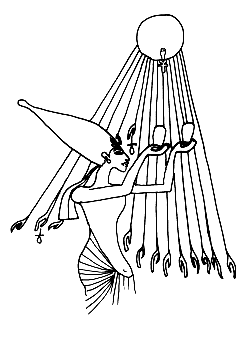
Bezeichnung der Sonnenscheibe als Himmelskörper, die bereits im Mittleren Reich verwendet wurde. Im frühen Neuen Reich war der Aton ein verbreiteter Ausdruck geworden, der schnell personifiziert wurde. In der frühen 18. Dynastie wurde das Wort mit einem Götterdeterminativ geschrieben. Der Durchbruch für den Aton geschah unter Amenophis IV./Echnaton, der den Gott als den einzigen Gott verehrte und die Existenz anderer Gottheiten ablehnte. Nach seiner Ansicht war der Aton der König, wie durch die Tatsache belegt ist, daß er den Namen des Gottes in zwei Kartuschen schrieb. Der volle Name des Aton, der mehrere Male während der Regierungszeit Amenophis' IV. verändert wurde, ist beinahe eine dogmatische Verkündung des Wesens des Gottes. Der Name, der dem Aton bei der Thronbesteigung Amenophis' IV. gegeben wurde, war 'Es lebe Re-Harachte, der im Lichtland jubelt in seinem Namen Schu, der der Aton ist'. In späteren Versionen des Namens verschwinden die Namen anderer Götter. Ursprünglich wurde der Gott als Mensch mit Falkenkopf und einer Sonnenscheibe mit Uräusschlange dargestellt. Etwa vom 2. Jahr des Königs an wurde jedoch nur noch die Sonnenscheibe selbst mit zahlreichen Sonnenstrahlen, die in Händen endeten, abgebildet. Manchmal halten einige dieser Hände Anch-Zeichen an die Nase des Königs und seiner Familienmitglieder. Gebete und Hymnen an den Aton sind uns in den Gräbern von El-`Amarna überliefert. Dort ersetzten sie die üblichen Totentexte. Der bekannteste ist der Große Atonhymnus, der anscheinend vom König selbst geschrieben worden war und neben anderen Orten im Grab des Eje in Achet-Aton angebracht war. Der Hymnus preist den Ruhm des Aton, wie er in der Schönheit seiner Schöpfung offenbar wird. Obwohl die Motive nicht neu waren, wurden sie nun ohne mythologische Anspielungen verwendet. Es ist gezeigt worden, daß der Text des Hymnus viel mit Psalm 104 der Bibel gemeinsam hat. Nach dem Tode Echnatons und der Aufgabe von Achet-Aton wurden die Tempel des Aton abgerissen und die Steine als Baumaterial für andere Tempel verwendet.